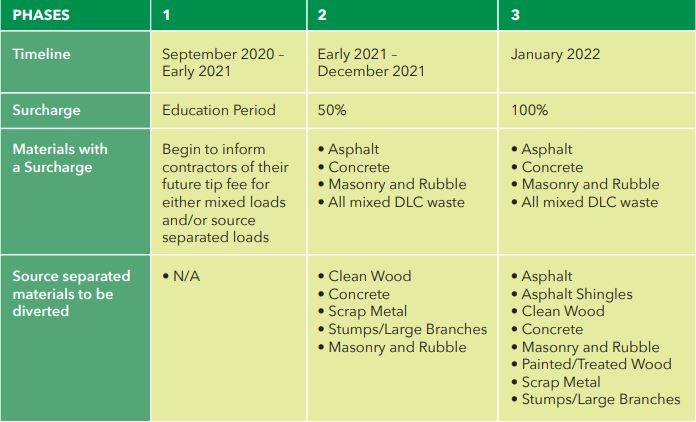The Regional District of Fraser-Fort George (RDFFG) is trying to keep recyclable construction waste out of the landfills.
Over 20,000 tonnes of demolition, land clearing and construction waste (DLC) was dumped in 2019 at the Foothills Boulevard Regional Landfill and 71 per cent of those loads, or over 14,400 tonnes, were mixed.
The RDFFG is implementing the first phase of its DLC construction waste diversion program, which aims to encourage people to recycle construction waste.
Phase One started Sept. 1 and focused on education with no changes in tipping fees, but during Phase Two, a surcharge will be introduced early 2021.
At first, there will be a smaller surcharge, in order to help customers, adapt to the change. Then, during Phase Three on Jan. 1, 2022, the full surcharge will come into effect.
“The overarching goal of this program is to divert recyclable DLC waste away from the landfill to other recycling options. Not all DLC waste with a differential tipping fee will see an increase,” said Laura Zapotichny, Manager of Waste Diversion Program, during last night’s (Oct. 5) presentation to Prince George city council.
 DLC diversion program phases. (via RDFFG)
DLC diversion program phases. (via RDFFG)A differential tipping fee means that not all DLC waste will have the same tipping fee.
Source separated loads of DLC waste will have different tipping fees from mixed loads of DLC.
Some harder to manage materials, and materials that have local recycling options, will also have a higher tipping fee to encourage recycling and diversion from being buried at the Landfill.
DLC waste is made up of asphalt, asphalt shingles, clean wood, clean soil, concrete, gypsum board or wallboard, masonry and rubble, painted and treated wood, scrap metal and stumps and large branches. Often this material comes in loads all mixed together.
The first step in the program is to encourage the separation of this waste.
Sorting these wastes from one another will allow the Regional District to divert more waste from the landfill, saving valuable landfill space, energy, and resources. In addition, the tipping fees for easily divertible material will also increase.
“The construction and waste diversion industry is always evolving. There is now a company that takes source-separated asphalt shingles and charges less of what we charge at our facility and staff will encourage users to use this facility or recycling,” added Zapotichny.
“Asphalt, concrete, masonry and rubble and mix DLC materials have their fees increased. These source-separated materials have their fees increased because they are bulky and negatively impact the settlement of waste in our landfill when buried. Furthermore, there are well established local businesses that accept these materials for recycling.”
She says the hope is that some of the other materials might be recycled and diverted from the Foothills Boulevard Regional Landfill soon, noting the program is incentivized to help users find places where they have the choice to recycle their waste and save money on fees.
“It gives that option if you are doing a really large project it is going to be worth it to source separate your load if you are doing a smaller project it might be easier to bring it to the landfill and pay the tipping fee,” says Zapotichny.
“Our goal is to work with the local construction industry so they are aware of their choices and can plan accordingly.”
Any customers using the Foothills Boulevard Regional Landfill with a large load of DLC waste will potentially be affected by these changes. To learn more you can visit sortsmart.ca.
.jpg;w=810)


